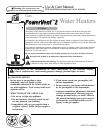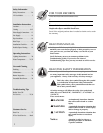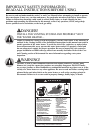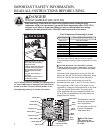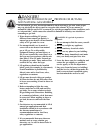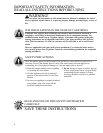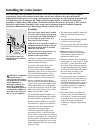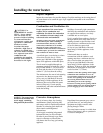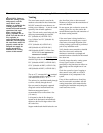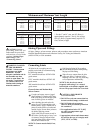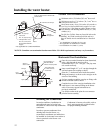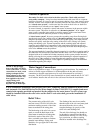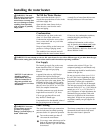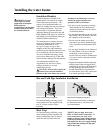
9
The water heater must be installed with the factory supplied blower assembly.
Venting
The water heater must be vented to the
outdoors as described in these instructions.
DO NOT connect this water heater to an
existing vent or chimney – it must be vented
separately from all other appliances.
Note: This unit can be vented using only the
following recommended pipe material.
PVC (Schedule 40, ASTM D-1785)
Coex Cellular Core PVC (Schedule 40,
ASTM F-891)
CPVC (Schedule 40, ASTM F-441)
ABS (Schedule 40, ASTM D-2661)
ABS (Schedule 40 DWV, Cellular Core,
ASTM -F628)
Not applicable for
installations in Canada.
The fittings, other than the TERMINATION,
should be equivalent to the following:
PVC (Schedule 40 DWV, ASTM D-2665)
CPVC (Schedule 40 DWV, ASTM F-438)
ABS (Schedule 40 DWV, ASTM D-2661)
The use of 2” vent material is not permitted
in the installation of this water heater. All
vent material MUST be 3” or 4”.
The unit may be vented horizontally through
a wall or vertically through the roof.
Pipe runs must be adequately supported
along both vertical and horizontal runs.
Maximum unsupported span is
recommended to be no more than 6 feet
(1.8 metres).
It is imperative that the first hanger be
located on the horizontal run immediately
adjacent to the first 90-degree elbow from
the vertical rise.
Support method used should isolate the vent
pipe from floor joists or other structural
members to help prevent the transmission of
noise and vibration.
Do not support, pin or otherwise secure the
venting system in a way that restricts the
normal thermal expansion and contraction of
the chosen venting material.
If the water heater is being installed as a
replacement for an existing power vented
water heater, a thorough inspection of the
existing venting system must be performed
prior to any installation work.
Verify that the correct materials as detailed
above have been used, and that the
minimum or maximum vent length and
terminal locations as detailed in this manual
have been met.
Carefully inspect the entire venting system
for any signs of cracks or fractures,
particularly at the joints between elbows or
other fittings and the straight runs of vent
pipe.
Check the system for signs of sagging or
other stresses in the joints as a result of
misalignment of any components in the
system.
If any of these conditions are found, they
must be corrected in accordance with the
venting instructions in this manual before
completing the installation and putting the
water heater into service.
DANGER: Failure to
install the venting system
and properly vent the
water heater to the
outdoors as outlined in the
Venting section of this
manual will result in unsafe
operation of the water
heater causing bodily
injury, explosion, fire or
death. To avoid the risk of
fire, explosion, or
asphyxiation from carbon
monoxide, NEVER operate
the water heater unless it is
properly vented and has
adequate air supply for
proper operation as
outlined in the Venting
section of this manual.



